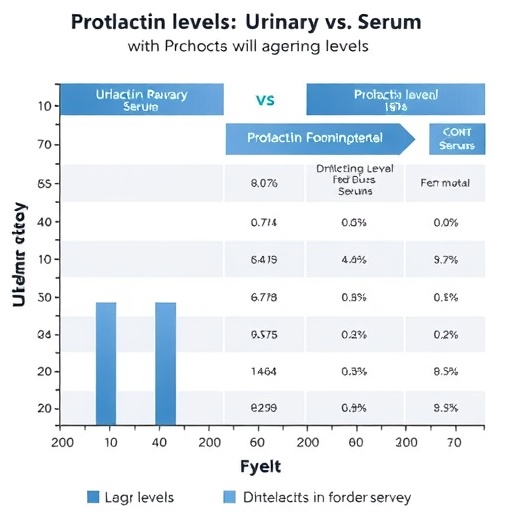Recent research spearheaded by prominent scientists has unveiled significant findings regarding prolactin levels and their implications in patients diagnosed with hyperprolactinemia and macroprolactinemia. The study, which meticulously compares urinary prolactin and the serum-to-urine prolactin ratio, aims to decipher the complexities surrounding these conditions that can lead to various health issues. The research underscores the importance of distinguishing between hyperprolactinemia and macroprolactinemia, concepts that, while similar, carry distinct clinical ramifications.
Prolactin, a hormone traditionally associated with lactation, is now understood to play a multifaceted role in human physiology. Analyzing the dynamics of this hormone reveals insights into not just reproductive health, but also metabolic processes and psychological well-being. Researchers in the field have become increasingly aware that anomalies in prolactin levels can signify underlying disorders, prompting the need for rigorous diagnostic measures.
In their study, the authors meticulously gathered data from a cohort of patients exhibiting symptoms consistent with either hyperprolactinemia or macroprolactinemia. Hyperprolactinemia refers to elevated levels of prolactin in the blood, often resulting from various causes, including medications, pituitary tumors, or other endocrine disorders. Meanwhile, macroprolactinemia, characterized by the presence of high molecular weight prolactin, may not indicate the same clinical concerns as its hyperprolactinemic counterpart.
One of the intriguing aspects of the research was the comparative analysis of urinary prolactin versus serum prolactin levels. Traditionally, medical professionals have leaned heavily on serum measurements in diagnosing prolactin-related disorders. However, the study explores whether urine samples could provide an equally valuable indicator of prolactin status. This could potentially pave the way for less invasive testing methods that are more readily available in clinical settings.
As patients grapple with the symptoms of these conditions—ranging from infertility to emotional disturbances—the implications of the study resonate on a personal level. By emphasizing the differences in prolactin production and clearance between individuals with hyperprolactinemia versus macroprolactinemia, the researchers aim to empower clinicians with the knowledge necessary to tailor treatment plans more effectively. A more nuanced understanding of these distinctions could significantly enhance patient outcomes.
The methodological approach employed by the researchers proves integral to the credibility of their findings. The utilization of sophisticated assays to measure both serum and urinary prolactin levels ensures the accuracy and reliability of the results. As methodologies in biochemical analysis continue to evolve, such advancements mark a shift towards more comprehensive patient evaluation techniques.
The researchers also highlight the necessity for further studies to explore the clinical significance of urinary prolactin measurements in relation to various treatment outcomes. As the medical community increasingly advocates for personalized medicine, understanding how different prolactin measurements correlate with therapeutic responses may illuminate vital pathways for patient management.
In addition to clinical applications, the research furthers our understanding of endocrine system interactions. Prolactin’s role as a hormone extends beyond its traditional confines; it is implicated in a multitude of physiological processes including metabolic regulation, immune function, and even behavior. This study emphasizes the need for a holistic perspective when addressing endocrine disorders.
The researchers’ work may also raise awareness among patients who have been historically underinformed about their conditions. Many individuals with elevated prolactin levels may not fully understand how this impacts their health trajectory. By disseminating these findings, the medical community can better educate patients, empowering them to advocate for their health and engage in informed discussions with healthcare providers.
While the study illustrates the importance of urinary prolactin analysis, it also acknowledges existing challenges. Current paradigms in endocrinology largely depend on serum prolactin measurements, which means the transition to considering urinary prolactin data may take time. Increasing acceptance within the medical community will be critical to harnessing the findings effectively.
As science often progresses through incremental advancements, the current research holds promise for future studies aimed at elucidating the biological intricacies of prolactin. Further investigation into the predictive value of urinary prolactin levels could lead to groundbreaking developments in the field of endocrinology. As methodologies become more refined, additional variables will surely emerge, further enriching the discourse surrounding these common yet complex conditions.
The potential impact of this research lies not only in clinical advancements but also in sparking broader conversations about hormone imbalances and their repercussions on health. The study serves as a reminder that hormonal health is multifactorial, and a one-size-fits-all approach may fall short in addressing the nuanced needs of patients.
In conclusion, the comparative analysis conducted by this team of dedicated researchers offers invaluable insights into the enigma of prolactin. By distinguishing the complexities between hyperprolactinemia and macroprolactinemia through urinary and serum comparisons, they have not only underscored the importance of accurate diagnostics but also set the stage for future studies that could alter the landscape of endocrine health management.
As aspirational as these findings may be, they reinforce the vital role of research in driving medical progress, aiming to enhance both knowledge and care for patients suffering from hormonal disorders. The future of prolactin-related research appears promising, heralding innovations that could usher in a new era of understanding both for practitioners and patients alike.
Subject of Research: Prolactin levels in hyperprolactinemic and macroprolactinemic patients.
Article Title: Comparison of urinary prolactin and serum/urine prolactin ratio in hyperprolactinemic and macroprolactinemic patients.
Article References:
Ein-Mozaffari, B., Aliasgharzadeh, A., Najafipour, F. et al. Comparison of urinary prolactin and serum/urine prolactin ratio in hyperprolactinemic and macroprolactinemic patients.
BMC Endocr Disord 25, 229 (2025). https://doi.org/10.1186/s12902-025-02052-6
Image Credits: AI Generated
DOI: 10.1186/s12902-025-02052-6
Keywords: Prolactin, Hyperprolactinemia, Macroprolactinemia, Endocrine Disorders, Urinary Prolactin, Serum Prolactin.




